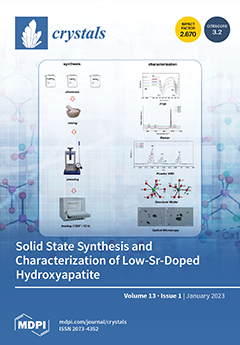Prediction of new materials is crucial for the advancement of technology. Here, in this research work, the first-principle computation has been conducted utilizing the WIEN2K package to probe the structural, electronic, mechanical, and optical properties of barium-based chloroperovskites BaMCl
3 (M = Ag,
[...] Read more.
Prediction of new materials is crucial for the advancement of technology. Here, in this research work, the first-principle computation has been conducted utilizing the WIEN2K package to probe the structural, electronic, mechanical, and optical properties of barium-based chloroperovskites BaMCl
3 (M = Ag, Cu) compounds. The optimized lattice constants are calculated for both compounds which are 9.90 Bohr for BaAgCl
3 and 9.38 Bohr for BaCuCl
3. To obtain better and more precise results for the electronic band’s structure, TDOS and PDOS (total and partial density of states), and the TB-mBJ potential approximation are employed. The indirect band gap (R–Γ) is found for both compounds having values of 1.173 eV and 2.30 eV for BaCuCl
3 and BaAgCl
3, respectively, which depicts its semiconducting nature. The calculation of elastic properties is conducted with IRelast code. The Cauchy pressure, Bulk modulus, Young’s modulus, Shear modulus, anisotropic ratio, Kleinman parameters, and Poisson’s ratio are calculated from the obtained elastic constants. The computation of elastic parameters indicates that the interested chloroperovskites are anisotropic, mechanically stable, hard to scratch, and ductile. From 0 eV to 40 eV incident photon energy ranges, the various optical parameter such as refractive index, absorption coefficient, dielectric function, reflectivity, extinction coefficient, and optical conductivity are analyzed. These compounds absorb maximum light within 5 to 25 eV incident photon energy. Hence, these materials are good light absorbers, therefore, they can be used in optoelectronic devices for high-frequency applications.
Full article





